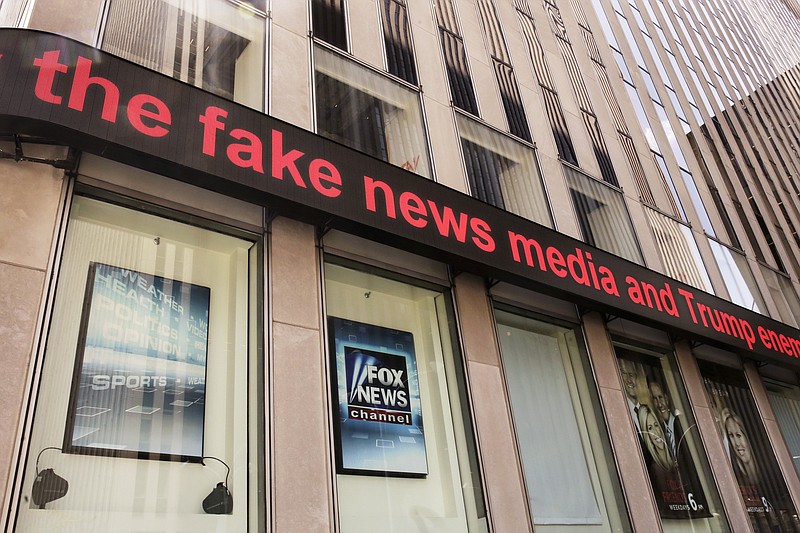There's fake news, and then there's really fake news.
There's fake news, which is what President Donald Trump and his conservative supporters call any news they don't like.
Then there's fake news like conservative-slanted Fox News.
And then there's really fake news - like the Russian bots that shaped our election with online propaganda and that continue to generally dumb us down with worthless entertainment chatter, ads designed to promote fear and division. Now we even have robo-calls (robot computer-generated phone calls) like the one that announced itself in Alabama last week as a reporter from The Washington Post.
In the robo-call, an exaggerated Yankee-accented voice claims to be "Bernie Bernstein" and offers thousands of dollars for damaging information about Roy Moore, a man who a growing number of Alabama women say made unwanted sexual advances to them when they were teens and he was in his 30s. The call is a complete fake designed to make Alabamians doubt the news about Moore.
Please note: This is not about Roy Moore. This is about "fake" news.
Not "fake news." Just the "fake" part.
There is a real difference. Note the "real" part. Sometimes the lines blur.
Let's deal with Fox News first: With each new drip, drip of the Trump/Russia probe, Fox talks about other stuff - like sanctuary cities and Dreamers and Uranium One.
Take, for instance, the Monday morning announcement that President Donald Trump's former campaign manager, Paul Manafort, was indicted and turned himself in to the FBI. All other new outlets covered that story all day and into the wee hours, pretty much nonstop.
Not Fox. Their version of "fake" news is best characterized as deflection.
During the day, Fox broke away from the Manafort news often to air other stories about tax reform, the corruption trial of Democratic Sen. Bob Menendez and - yes, the Fox evergreen story about some aspect of immigration.
"Fox & Friends" interviewed Kellyanne Conway, who talked about "coordination, if not collusion" between the Clinton campaign, the DNC and the infamous Russian dossier allegations about Trump and Russia.
Fox's evening opinion star, Tucker Carlson, led his broadcast with "the Real Russia scandal," which was about the Clintons and Democrats. Carlson told viewers that the Manafort indictment "never mentions Donald Trump's presidential campaign, or the 2016 election. It only mentions Russia in passing, even though Russian meddling was the pretext for this investigation in the first place."
Sean Hannity, another opinion host, talked of "Robert Mueller's witch hunt. There is zero evidence of Trump, Russia collusion, zero evidence of campaign collusion," he said. "And in spite of all of that, the media has been lying to you all day, and all weekend long." The real story, Hannity told viewers, was that Clinton had "sold out America's national security interest." He was talking about the Uranium One conspiracy theory, a trumped-up (pun intended) allegation by a Breitbart editor in his book titled "Clinton Cash."
Media Matters, a progressive online research site that analyzes conservative media sites, recently noted that for three weeks between Oct. 17 through Nov. 6 - as the Russia/Trump probe picked up steam - Fox News devoted nearly 12 hours to the Uranium One story. At the same time, President Trump and some members of Congress called for Attorney General Jeff Sessions to appoint a second special counsel to investigate Uranium One and the Hillary Clinton.
The coverage screamed: Don't look at Trump and Russia. Look over there!
Credit is due to Fox News anchor Shep Smith, who in his Fox show on Tuesday, methodically debunked the theory.
"Here's the accusation," Smith told his viewers. "Nine people involved in the deal made donations to the Clinton Foundation totaling more than $140 million. In exchange, Secretary of State Clinton approved the sale to the Russians - a quid pro quo.
"The accusation is predicated on the charge that Secretary Clinton approved the sale," Smith continued in a nearly 7-minute segment. "She did not. A committee of nine evaluated the sale, the president approved the sale, the Nuclear Regulatory Commission and others had to offer permits, and none of the uranium was exported for use by the U.S. to Russia. That is Uranium One."
Further, $136 million of the donations to the Clinton Foundation came from one donor who had sold his shares in the Uranium One company three years before he made the donations and before Clinton became Secretary of State.
Fox viewers are livid and want Smith fired, of course.
But all readers and viewers of all news and opinion need to take a deep breath, be their own best friends and do some research on their own. Don't just watch one television network. Don't read just one newspaper. Don't fall for clickbait or hyper-partisan opinion. (You'll notice we give you both a liberal and a conservative editorial page every day.)
And never, ever blindly take as fact anything you see on Facebook.
If you do see or hear a story that raises the hair on the back of your neck, go to another network or newspaper for another version, or Google it with "fact check" in the search line.
Ask these questions: Who made this? Who is the target audience? Who paid for it? Or, who gets paid if I click on it? Who might benefit or be harmed by this? What is left out of this that might be important? Is this credible and what makes us think so?
Fake news, like beauty, is in the eyes of the beholder. And we all need to look beyond what we think is a pretty face.
